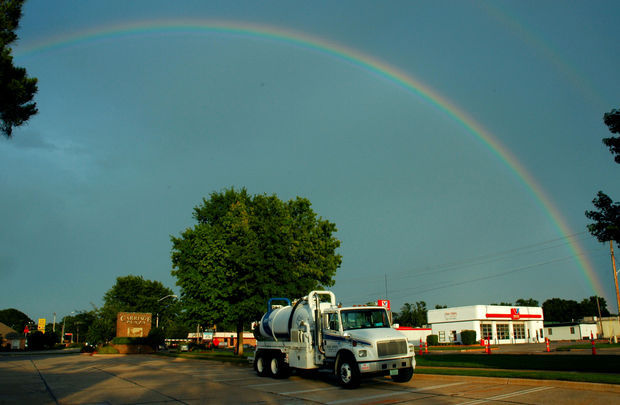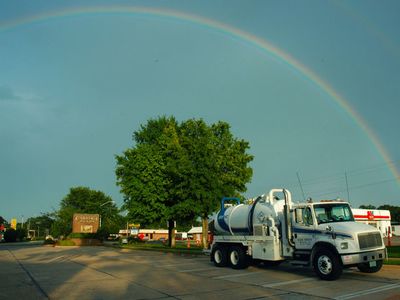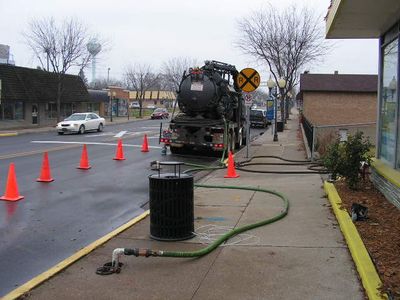Search: Site This Page
(405) 360-1552

| Ecovac Services / Projects / Gasoline / |
SURFAC Projects
Type of Facility: Former Service Stations (2)
Location: Norman, Oklahoma
Releases from two former UST sites created a very large plume beneath multiple businesses, a state highway, and threatened nearby residences. The SPH plume was estimated to be 550 feet by 250 feet (> 2 acres) and the benzene plume 700 feet by 400 feet (>5 acres). EcoVac Services mobilized multiple treatment units and arrived onsite within one day of contract execution. SURFAC® was implemented to remove the SPH and ISCO-EFR® was subsequently utilized to reduce dissolved benzene concentrations. The SPH was removed within 45 days (May to July 2007). Dissolved benzene has been reduced below corrective action levels across most of the entire plume. SPH remains absent 13 months after implementation.
Type of Facility: Inactive Service Station
Location: Nashville, Tennessee
EcoVac Services was contacted by the Tennessee DEC to remove SPH from two monitor wells that historically contained SPH (gasoline). The subsurface consisted of limestone at less than two feet below grade. Water levels in the monitor wells are fracture controlled, as evidenced by the range of groundwater elevations (ranging from 3 to 30 feet). Although SPH was not detected prior to the SURFAC® Pilot Test Event conducted in August 2005, this event did mobilize SPH into MW-9 (0.25 feet) prior to the Surfactant Injection Event. Following the removal of SPH, site closure was achieved.
Type of Facility: Service Station
Location: Clarksville, Tennessee
EcoVac Services was contacted by the Tennessee DEC to remove SPH (gasoline) from the subject site. Historically, SPH had been present in five monitor well and four tank field wells. Two SURFAC applications were implanted in August and December 2005. Although SPH did return to the tank field observation wells, it was observed that the UST system did not possess overspill protection, resulting in overspills during gasoline deliveries.
Type of Facility: Inactive Service Station
Location: Martinsville, Virginia
EcoVac Services was contacted by the Virginia DEQ to remove SPH from two monitor wells that historically contained SPH (gasoline). The primary driver for this site was the presence of MTBE in a downgradient spring. Depth to water was 12 feet and the surficial aquifer consisted primarily of a silty clay. SURFAC® was conducted in November 2005. SPH has not returned.
Type of Facility: Inactive Service Station
Location: Chase City, Virginia
EcoVac Services was contacted by the Virginia DEQ to remove SPH from a site that historically contained SPH. Two monitor well containing SPH at thicknesses of 0.06 and 0.22 feet was present prior to the SURFAC® Pilot Test Event. The aquifer was present in a silty clay aquifer in the Piedmont. A SURFAC® Pilot Test Event, Surfactant Injection Event, two Surfactant Capture Events and a Surfactant Polishing Event were conducted in March to April 2006. A 90% reduction in SPH (0.02 feet in one monitor well) was achieved.
Type of Facility: Inactive Service Station
Location: Danville, Virginia
EcoVac Services was contacted by the Virginia DEQ to remove SPH from a site that historically contained SPH in two monitor wells. Previous remedial activities consisted of hand bailing and 11 MPE events by another provider. A SURFAC® pilot test event, injection event, and three capture events were conducted in March to April 2006. SPH was reduced in two monitor wells from thicknesses of 0.14 and 0.30 feet to approximately 0.25 feet in one well.
Type of Facility: Service Station
Location: Huntsville, Alabama
As much as 7.05 feet of SPH (gasoline/diesel fuel mix) were present in two wells for several years. Four EFR® events reduced the SPH to a sheen. SURFAC® was implemented in December 2006 at the site, resulting in the complete removal of SPH.
Type of Facility: Former Pipeline Site
Location: Baltimore, Maryland
SPH had historically been present in several wells at this highly permeable site located near Curtis Bay/Patapsco River. Depth to water ranged from 35 to 45 feet. Two SPH (gasoline) plumes measured nearly 250 feet in length. Two SURFAC® Pilot Test Events conducted in May 2006 reduced SPH in three wells ranging in thickness from 0.01 to 0.80 feet (aggregate thickness 1.56 feet) by over 60%. Vacuum influence was observed nearly 200 feet distant from the extraction wells. SURFAC® completely removed SPH and site closure was achieved.
Type of Facility: Former Bulk Plant
Location: Watervliet, Michigan
Approximately 92,000 gallons of gasoline was released in the vicinity of the subject property in 1948. The subsurface at the site consists of a highly variable glacial till. Depth to groundwater ranges from 20 to 25 ft. An investigation conducted in 2000 revealed the presence of SPH at the site. SPH collection events were performed from November 2000 through September 2002, at which time an interim SPH recovery system (down hole bladder pump) was installed. The recovery system had collected approximately 316 gallons of SPH.
SPH was present in five monitor wells, with thicknesses ranging from 0.02 feet to 1.05 feet (2.83 ft aggregate) during four EFR® events conducted by EcoVac Services from June through October 2006. These EFR® events reduced SPH thicknesses to 0.20 feet in two wells at a cost of $15,561, inclusive of fluid disposal.
SURFAC® was implemented over a four-day period from November 2006 through January 2007, involving the injection and recovery of 1,800 gallons of diluted surfactant mixture at five monitor wells. SPH was completely absent for over one year. EFR® was used to remove small quantities of SPH that appeared 15 months after SURFAC®. The reappearance of SPH may have been due to the inability of the surfactant aqueous solution to come into contact with SPH trapped in or around fill material, foundations or utility conduits present under the current building and roadway. The site is currently being evaluated for site closure.
Type of Facility: Rental Truck Facility
Location: Del City, Oklahoma
EcoVac Services, Inc. was contracted by an environmental consulting firm under the direction of the Oklahoma Corporation Commission (OCC) to remove SPH (gasoline) at a rental truck facility. The SPH plume emanated from a gasoline UST tank field and fuel island, located at opposite sides of the property and covered an area of approximately 250 feet by 150 feet, and 13,900 yd3. The site is underlain by clay, silty clay, and sandy clay, with occasional clayey sand lenses. The groundwater table fluctuates from 7 to 17 feet bgs. Groundwater flow rates are approximately 10-4 to 10-6 cm/s. The contamination (smear zone) lies between 5 to 18 feet bgs, in interbedded clay, silty clay, sandy clay, and thin clayey sand lenses.
EcoVac designed the remediation well network, consisting of 18 wells, and provided oversight during installation. SPH was present in seventeen monitor wells ranging in thickness from 0.03 to 2.39 feet prior to the implementation of EFR® and SURFAC® activities. EFR® was implemented for two weeks in January and February, 2008 to reduce SPH thicknesses and reduce the area of hydrocarbon contamination. SURFAC® was implemented in February through March, 2008 to completely remove the SPH. SPH was completely removed from the site and site closure was achieved.
Type of Facility: Former Rubber Manufacturing Plant
Location: Madison, Tennessee
Piping leaks to an aboveground tank and oil/water separator are believed to have resulted in a SPH (Stoddard solvent) plume, which covered an area of over 20,000 square feet. Groundwater is present in a limestone bedrock aquifer at depths ranging from approximately 10 to 40 feet below grade. The bedrock aquifer is overlain by silty clay.
Nine extraction wells were installed prior to EFR® activities. SPH, ranging in thicknesses from 0.03 to 9.24 feet, was present in 12 wells during ten EFR®activities conducted from March 2007 to December 2007. Ten EFR® events reduced SPH to three wells, ranging in thicknesses from 0.10 to 0.89 feet, a 92% reduction. SURFAC®, conducted in September and October 2009, removed SPH in all of the treatment wells. SPH (0.12 feet) did appear in two nontreatment wells following SURFAC®. The site is being evaluated for site closure.
Type of Facility: Service Station
Location: Oklahoma City, Oklahoma
EcoVac Services was retained to remove SPH at the subject site after a prominent surfactant remediation firm failed to do so. SPH covered an area of approximately 5,000 square feet and ranged in thicknesses from 0.15 to 5.28 feet in nine wells prior to the previous firm’s remediation efforts. Post remediation efforts resulted in increased SPH thicknesses across the site at a cost of $291,270. The SPH plume increased to approximately 7,250 square feet, SPH thicknesses averaged an increase of 0.73 feet across the site, and SPH had appeared in four additional wells for the first time. Previous remediation also left an in-situ emulsified groundwater/hydrocarbon mixture.
The previous remediation firm proposed an additional $310,337, excluding a proposed installation of 40 additional wells, after its failure to remove SPH at the site. EcoVac implemented EFR® and SURFAC®® was initially implemented March 5 to 15, 2009 to reduce the size and thickness of the SPH plume. SURFAC® was then implemented from March 16, 2009 to May 1 2009 to completely remove SPH. SPH and in-situ emulsion was completely removed from site within 57 calendar days (34 field days) of implementation at a cost of $263,000 (Guaranteed cleanup contract).

Birmingham, Alabama
BP #24248
EcoVac Services Inc. performed two days of pilot testing, one day of surfactant injection and three capture events to remove SPH at this site. The aggregate SPH thickness was 3.60 feet present in four wells prior to the pilot testing.
Surfactant injection and capture was performed in October 2009. A total of 6,545 gallons of impacted groundwater and surfactant were removed in this process.
Confirmation gauging was performed by the consultant in January 2010 and results indicate no SPH in any of the wells onsite. Reductions in dissolved phase BTEX constituents in groundwater sampling results were observed in wells that previously had SPH.
Project cost was less than $35,000 including disposal.
BP #24255
EcoVac Services Inc. performed one day of pilot testing, one day of surfactant injection and four capture events to remove SPH at this site. The aggregate SPH thickness was 1.05 feet present in three wells prior to and after the pilot testing.
Surfactant injection and capture was performed in October 2009. A total of 5,056 gallons of impacted groundwater and surfactant were removed in this process.
Confirmation gauging was performed by the consultant in January 2010 and results indicate no SPH in any of the wells onsite. Reductions in dissolved phase BTEX constituents in groundwater sampling results were observed in wells that previously had SPH.
Project cost was less than $39,000 including disposal.
Birmingham, Alabama
BP #24248
EcoVac Services Inc. performed two days of pilot testing, one day of surfactant injection and three capture events to remove SPH at this site. The aggregate SPH thickness was 3.60 feet present in four wells prior to the pilot testing.
Surfactant injection and capture was performed in October 2009. A total of 6,545 gallons of impacted groundwater and surfactant were removed in this process.
Confirmation gauging was performed by the consultant in January 2010 and results indicate no SPH in any of the wells onsite. Reductions in dissolved phase BTEX constituents in groundwater sampling results were observed in wells that previously had SPH.
Project cost was less than $35,000 including disposal.
BP #24255
EcoVac Services Inc. performed one day of pilot testing, one day of surfactant injection and four capture events to remove SPH at this site. The aggregate SPH thickness was 1.05 feet present in three wells prior to and after the pilot testing.
Surfactant injection and capture was performed in October 2009. A total of 5,056 gallons of impacted groundwater and surfactant were removed in this process.
Confirmation gauging was performed by the consultant in January 2010 and results indicate no SPH in any of the wells onsite. Reductions in dissolved phase BTEX constituents in groundwater sampling results were observed in wells that previously had SPH.
Project cost was less than $39,000 including disposal.


